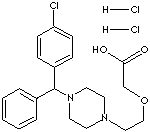PRODUCT IDENTIFICATION
83881-52-1 (Dihydrochloride)

H.S. CODE
TOXICITY
CLASSIFICATION
EXTRA NOTES
PHYSICAL AND CHEMICAL PROPERTIES
AUTOIGNITION
NFPA RATINGS
REFRACTIVE INDEX
Stable under ordinary conditions. Hygroscopic.
EXTERNAL LINKS & GENERAL DESCRIPTION
http://www.drugbank.ca/
Mechanism of action:
Cetirizine competes with histamine for binding at H1-receptor sites
on the effector cell surface, resulting in suppression of histaminic edema,
flare, and pruritus. The low incidence of sedation can be attributed to reduced
penetration of cetirizine into the CNS as a result of the less lipophilic
carboxyl group on the ethylamine side chain.
Drug Information Portal (U.S. National Library of Medicine) - Cetirizine
http://www.nlm.nih.gov/
Cetirizine
is used to temporarily relieve the symptoms of hay fever (allergy
to pollen, dust, or other substances in the air) and allergy to
other substances (such as dust mites, animal dander, cockroaches,
and molds). These symptoms include sneezing; runny nose; itchy,
red, watery eyes; and itchy nose or throat. Cetirizine is also used
to treat itching and redness caused by hives. However, cetirizine
does not prevent hives or other allergic skin reactions. Cetirizine
is in a class of medications called antihistamines. It works by
blocking the action of histamine, a substance in the body that causes
allergic symptoms. Cetirizine is also available in combination with
pseudoephedrine (Sudafed, others). This monograph only includes
information about the use of cetirizine alone. If you are taking
the cetirizine and pseudoephedrine combination product, read the
information on the package label or ask your doctor or pharmacist
for more information.
Local:
Cetirizine is a selective H1-receptor antagonist used to treat allergic rhinitis
and chronic idiopathic urticaria, and as a treatment adjunct in asthma. It is a
racemic mixture of levo- and dextro-form, but levo-form is active. Chemically it
is described as (1S.2S)-2-methylamino-1-phenyl-1-propanol. The hydrochloride
salt of cetirizine is a white powder freely soluble in water, practically
insoluble in acetone and dichloromethane; administered orally.
BIBLIOGRAPHY
EP2000
APPEARANCE
ASSAY
0.5% max
0.2% max
HEAVY METALS
10ppm max
0.2% max (total impurity: 0.5% max)
GHS
PICTOGRAMS

HAZARD STATEMENTS
H302 Harmful if swallowed
PRECAUTIONARY STATEMENTS
![]() Xn
Harmful
Xn
Harmful
RISK PHRASES
22 Harmful if swallowed
SAFETY PHRASES